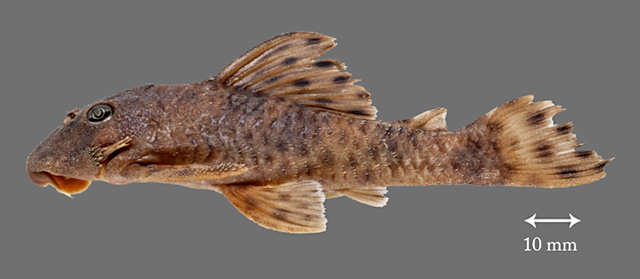| Loricariidae (Armored catfishes), subfamily: Hypostominae |
| 7.59 cm SL (male/unsexed) |
|
demersal; freshwater; pH range: 5 - 6.4 |
| South America: Approuague River in French Guiana. |
|
Dorsal spines (total): 2-2; Dorsal soft rays (total): 7-7; Anal soft rays: 5-5. This species can be diagnosed from other Guianese species by its specific barcode sequence (JF747000) and from all congeners except Peckoltia oligospila, P. bachi, P. sabaji, P. simulata, and P. otali by having a spotted pattern of coloration of posterior part of body. In contrast to these five species, this fish has no spot present on the head. It differs further from the spotted species as well as from most other Peckoltia species by having a shorter head (length 33.4-33.6% SL vs. more than 33.7). It is readily distinguished from both P. bachi and P. otali by rounded spotting (vs. mottling); from P. bachi by a much narrower interorbital (34.4-34.5% HL, mean 34.5, vs. 57.9-59.9, mean 58.8); from P. otali by several measurements; from P. sabaji by smaller spots on caudal peduncle and less slender body. It can be further diagnosed from P. oligospila by lower occipital depth (18.4-20.4% SL, mean 19.4, vs. 21.1-23.4, mean 21.9), smaller cleithral width (30.3-30.5% SL, mean 30.4, vs. 30.9-32.8, mean 32.1) and shorter orbital diameter (6.5-7.0% SL, mean 6.8, vs. 6.9-8.1, mean 7.4); from P. oligospila and
P. simulata by a shorter dorsal-fin spine (27.7-27.9% SL, mean 27.8, vs. more than 28.4) and higher caudal peduncle (11.3-11.7% SL, mean 11.5, vs. less than 10.6); and from
P. simulata by tooth shape and length of hypertrophied cheek odontodes (Ref. 90183). |
| Collected in swift current at a single place of Approuague River. During the time of collection, the river was very turbid as a result of illegal gold mining activities (Ref. 90183). |
|
Critically Endangered (CR); Date assessed: 14 January 2021 (B2ab(iii)) Ref. (130435)
|
| harmless |
Source and more info: www.fishbase.org. For personal, classroom, and other internal use only. Not for publication.

